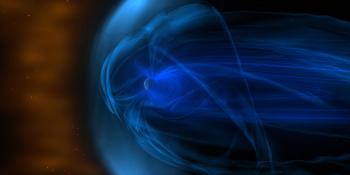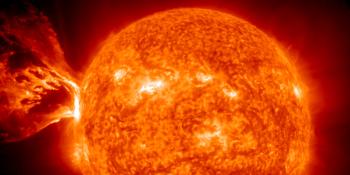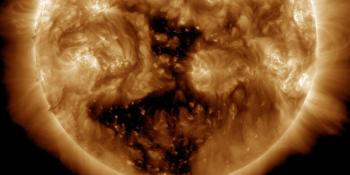Viewing archive of Wednesday, 7 January 2004
Solar activity report
Any mentioned solar flare in this report has a scaling factor applied by the Space Weather Prediction Center (SWPC). Because of the SWPC scaling factor, solar flares are reported as 42% smaller than for the science quality data. The scaling factor has been removed from our archived solar flare data to reflect the true physical units.
Report of Solar-Geophysical Activity 2004 Jan 07 2200 UTCPrepared by the NOAA © SWPC and processed by SpaceWeatherLive.com
Joint USAF/NOAA Report of Solar and Geophysical Activity
SDF Number 007 Issued at 2200Z on 07 Jan 2004IA. Analysis of Solar Active Regions and Activity from 06-2100Z to 07-2100Z
Solar activity was high. An M4 x-ray event occurred at
0404 UTC and an M8 x-ray event occurred at 1027 UTC. Both events
were from Region 537 (N07E64) and were associated with type II
sweeps and CMEs off the east limb. The region rotated more fully
into view today as a small (280 millionths) but bright and
magnetically complex sunspot group. Region 536 (S11W02) continues to
be the largest group on the disk and is maintaining its
beta-gamma-delta configuration. There was some indication today that
the region may be slowly decaying. Region 536 could only manage to
produce a couple B-class events. Two new, small, simple regions
emerged on the disk today: Region 538 (N07E04) and Region 539
(N09E29).
IB. Solar Activity Forecast
Solar activity is expected to be
moderate with a chance for isolated major flare activity. Region 537
is expected to remain active and Region 536 still has the potential
for producing significant flare activity as well.
IIA. Geophysical Activity Summary 06-2100Z to 07-2100Z
The geomagnetic field ranged from unsettled to major storm levels
during the past 24 hours. An enhancement in the solar wind flow was
observed at ACE, beginning 2000 UTC on 06 January. The enhancement
consisted of an increase in total field and in solar wind velocity,
and included some extended negative Bz intervals in the -1 to -10 nT
range. Although the flow was somewhat atypical (low density, high
temperature), the signatures appear to be consistent with a CME led
by a compression wave and expanding in low density solar wind that
originated in association with the M6 x-ray event on 5 January. The
slow rotation of Bz from negative to positive during the last 18
hours resulted in a decrease in geomagnetic activity during the last
5-6 hours of the period. The greater than 2 MeV electron fluxes were
high during the past 24 hours.
IIB. Geophysical Activity Forecast
The geomagnetic field is
expected to be mostly active with some minor storm periods for 08
January based on the continued influence of a high speed solar wind
stream. Mostly active conditions should predominate on 09 January
and a decline to mostly unsettled levels is expected on 10 January.
III. Event Probabilities 08 Jan to 10 Jan
| Class M | 65% | 65% | 65% |
| Class X | 15% | 15% | 15% |
| Proton | 05% | 05% | 05% |
| PCAF | green | ||
IV. Penticton 10.7 cm Flux
Observed 07 Jan 119 Predicted 08 Jan-10 Jan 120/125/125 90 Day Mean 07 Jan 135
V. Geomagnetic A Indices
Observed Afr/Ap 06 Jan 017/020 Estimated Afr/Ap 07 Jan 030/030 Predicted Afr/Ap 08 Jan-10 Jan 025/030-020/020-015/015
VI. Geomagnetic Activity Probabilities 08 Jan to 10 Jan
| A. Middle Latitudes | |||
|---|---|---|---|
| Active | 35% | 30% | 25% |
| Minor storm | 25% | 20% | 15% |
| Major-severe storm | 15% | 10% | 05% |
| B. High Latitudes | |||
|---|---|---|---|
| Active | 15% | 25% | 25% |
| Minor storm | 50% | 35% | 25% |
| Major-severe storm | 25% | 20% | 15% |
All times in UTC
Latest news
Latest forum messages
2025/04/12-13 Filament CMEs 2025/04/16 G3 Watch 458Power Grid Reclosers 1AR4062 36Incoming & Unnumbered Active Regions 1741AR4064 8
More topicsSupport SpaceWeatherLive.com!
A lot of people come to SpaceWeatherLive to follow the Sun's activity or if there is aurora to be seen, but with more traffic comes higher server costs. Consider a donation if you enjoy SpaceWeatherLive so we can keep the website online!

Latest alerts
Wednesday, 16 April 2025
21:45 UTC - Geomagnetic activity
Minor G1 geomagnetic storm (Kp5) Threshold Reached: 21:36 UTC
21:00 UTC - Geomagnetic activity
Severe G4 geomagnetic storm (Kp8) Threshold Reached: 20:55 UTC
19:45 UTC - Geomagnetic activity
Strong G3 geomagnetic storm (Kp7) Threshold Reached: 19:25 UTC
19:00 UTC - Geomagnetic activity
Moderate G2 geomagnetic storm (Kp6) Threshold Reached: 18:38 UTC
18:45 UTC - Geomagnetic activity
Minor G1 geomagnetic storm (Kp5) Threshold Reached: 18:28 UTC
Space weather facts
| Last X-flare | 2025/03/28 | X1.1 |
| Last M-flare | 2025/04/15 | M1.2 |
| Last geomagnetic storm | 2025/04/15 | Kp6+ (G2) |
| Spotless days | |
|---|---|
| Last spotless day | 2022/06/08 |
| Monthly mean Sunspot Number | |
|---|---|
| March 2025 | 134.2 -20.4 |
| April 2025 | 124.1 -10.1 |
| Last 30 days | 122.5 -17.8 |







